色谱分析法综述
色谱分析报告

色谱分析报告引言色谱分析是一种常用的分析技术,用于分离化学物质混合物中的成分。
在本次实验中,我们使用了气相色谱(Gas Chromatography,GC)和液相色谱(Liquid Chromatography,LC)两种色谱技术来分析样品中的化合物。
本报告将详细描述实验的目的、方法、结果和讨论,旨在通过色谱分析的结果揭示样品中目标化合物的特性。
目的本实验的目的是通过GC和LC技术,对给定样品进行色谱分析,确定样品中目标化合物的含量和纯度,并对分析结果进行解读。
方法1. 实验仪器和试剂•GC仪器:柱型、检测器类型等•LC仪器:柱型、检测器类型等•色谱柱:GC柱型、GC柱长度、GC柱内衬等•样品溶剂:用于制备样品溶液的溶剂,包括溶剂纯度和配比等2. 样品制备与处理•样品的来源和样品性质的描述•样品预处理方法:如提取、萃取、纯化等3. GC分析条件•GC柱类型和规格•初始柱温和升温程序•检测器类型和参数设置•载气类型和流速4. LC分析条件•LC柱类型和规格•流动相和流速•检测器类型和参数设置5. 数据处理方法•样品峰面积计算方法•目标化合物含量和纯度计算公式•实验结果的统计学处理方法(如平均值、标准偏差等)结果经过GC和LC分析,我们获得了以下结果:1. GC分析结果通过GC分析,我们发现样品中存在两个目标化合物。
它们的峰面积分别为A和B,峰面积比为1:2。
经过计算,我们确定样品中A的含量为50%(相对峰面积),B的含量为100%。
这表明样品中B的含量是A的两倍。
2. LC分析结果通过LC分析,我们发现样品中存在三个目标化合物。
它们的峰面积分别为X、Y和Z,峰面积比为2:3:5。
经过计算,我们确定样品中X的含量为20%(相对峰面积),Y的含量为30%,Z的含量为50%。
这表明样品中Z的含量是X的2.5倍。
讨论通过本次色谱分析,我们成功地确定了给定样品中目标化合物的含量和纯度。
我们发现该样品中的化合物A和X含量较低,而B和Z含量较高。
色谱分析方法在石化分析领域的应用

色谱分析方法在石化分析领域的应用发布时间:2021-06-01T10:30:46.747Z 来源:《基层建设》2021年第2期作者:孙伟[导读] 摘要:文章阐述了石油化工领域对色谱分析方法的需求,分析了色谱分析方法在石油化工领域的实际应用及实施情况。
大庆石化公司质量检验中心摘要:文章阐述了石油化工领域对色谱分析方法的需求,分析了色谱分析方法在石油化工领域的实际应用及实施情况。
在综述色谱分析方法的基础上,简要介绍了色谱分析方法的作用,指出了色谱分析方法应用于石油化工分析的优点。
色谱分析方法在石油化工分析领域的实际应用以及如何做好色谱分析工作。
1.色谱分析方法综述色谱分析法是20世纪发展起来的一种有效的分析分离方法,又称色谱法。
石化产品的制造有许多不可避免的缺陷,色谱分析方法在石油化工分析领域有可行性和实用性。
2色谱分析法是基于不同物质特性(溶解度、极性、离子交换容量、分子大小等)的分析方法。
如果移动相通过固定相进行样品,则应分两步连续重新分配样品成分,以获得分离和纯化,以便于对样品进行定性和定量分析。
对于分类,有两种常用的色谱法,即液相色谱法和气相色谱法;色谱分析法通常用于各种石化工业组合中的原料、试剂和产品的色谱分析和样品检测。
它还可以很容易地分离和纯化样品,并通过内部分子量标准对化合物进行单独和定性定量的鉴定,以实现对石化工业各个环节的有效控制。
在生产中监控产品质量,色谱分析法基于特定的色谱分析工具,属于石油化学分析中使用的仪器分析。
由于色谱分析法是一种常见的、样品分析精度高的分析方法,在我国石油化工分析领域得到了广泛的应用,对石油化工生产具有重要的指导意义。
2.1.节约成本,提高经济效益色谱分析方法在国内外比较成熟。
色谱分析法可应用于化工产品的生产,减少或避免石化企业的经济损失,提高经济效益。
另外,对目前比较成熟、比较齐全的色谱分析设备也进行了改进。
在方法和控制水平上都具有较高的精度,提高经济效益。
薄层色谱分析技术综述
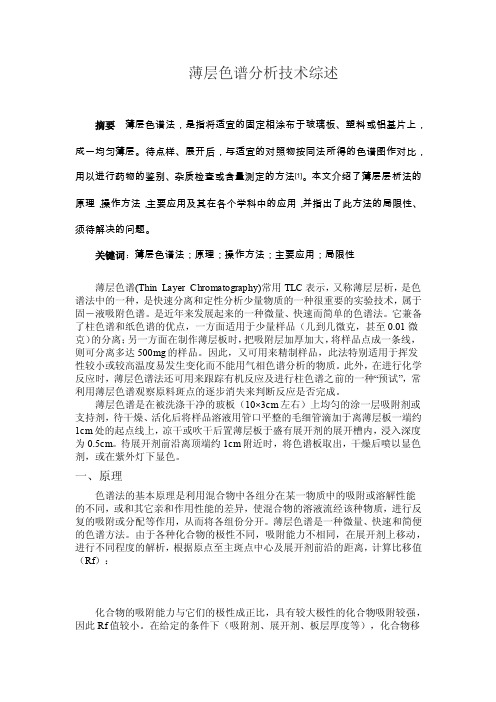
薄层色谱分析技术综述摘要薄层色谱法,是指将适宜的固定相涂布于玻璃板、塑料或铝基片上,成一均匀薄层。
待点样、展开后,与适宜的对照物按同法所得的色谱图作对比,用以进行药物的鉴别、杂质检查或含量测定的方法[1]。
本文介绍了薄层层析法的原理,操作方法,主要应用及其在各个学科中的应用,并指出了此方法的局限性、须待解决的问题。
关键词:薄层色谱法;原理;操作方法;主要应用;局限性薄层色谱(Thin Layer Chromatography)常用TLC表示,又称薄层层析,是色谱法中的一种,是快速分离和定性分析少量物质的一种很重要的实验技术,属于固-液吸附色谱。
是近年来发展起来的一种微量、快速而简单的色谱法。
它兼备了柱色谱和纸色谱的优点,一方面适用于少量样品(几到几微克,甚至0.01微克)的分离;另一方面在制作薄层板时,把吸附层加厚加大,将样品点成一条线,则可分离多达500mg的样品。
因此,又可用来精制样品,此法特别适用于挥发性较小或较高温度易发生变化而不能用气相色谱分析的物质。
此外,在进行化学反应时,薄层色谱法还可用来跟踪有机反应及进行柱色谱之前的一种“预试”,常利用薄层色谱观察原料斑点的逐步消失来判断反应是否完成。
薄层色谱是在被洗涤干净的玻板(10×3cm左右)上均匀的涂一层吸附剂或支持剂,待干燥、活化后将样品溶液用管口平整的毛细管滴加于离薄层板一端约1cm处的起点线上,凉干或吹干后置薄层板于盛有展开剂的展开槽内,浸入深度为0.5cm。
待展开剂前沿离顶端约1cm附近时,将色谱板取出,干燥后喷以显色剂,或在紫外灯下显色。
一、原理色谱法的基本原理是利用混合物中各组分在某一物质中的吸附或溶解性能的不同,或和其它亲和作用性能的差异,使混合物的溶液流经该种物质,进行反复的吸附或分配等作用,从而将各组份分开。
薄层色谱是一种微量、快速和简便的色谱方法。
由于各种化合物的极性不同,吸附能力不相同,在展开剂上移动,进行不同程度的解析,根据原点至主斑点中心及展开剂前沿的距离,计算比移值(Rf):化合物的吸附能力与它们的极性成正比,具有较大极性的化合物吸附较强,因此Rf值较小。
有机分析气相色谱分析法

有机分析气相色谱分析法一、GC的原理GC是一种基于样品挥发性物质在固定相柱中传质的方法。
样品在高温下气化,进入气相色谱柱。
柱子中填充了一种固定相,用来分离混合物中的化合物。
不同化合物在固定相上的亲和力不同,因此会按照相对亲和力的大小顺序通过柱子,最终达到分离的目的。
二、GC的仪器设备GC仪器主要由进样系统、色谱柱、检测器和数据处理系统组成。
进样系统用于将样品引入色谱柱。
色谱柱是分离化合物的关键,通常由玻璃制成,内部填充着固定相。
检测器用于检测化合物,并将信号转化为电信号。
数据处理系统用于记录和分析检测到的信号。
三、GC的操作步骤1.样品制备:将待分析的样品制备成气相可挥发的形式,例如通过溶解或萃取等方法。
2.进样:将样品注入进样器中,通过进样系统引入柱子中。
3.分离:样品在柱子中被分离,分离速度取决于化合物的挥发性和在固定相上吸附的亲和力大小。
4.检测:化合物通过柱子后,进入检测器。
根据检测器的原理,可以获得不同化合物的信号。
5.数据处理:将检测到的信号转化为峰,通过峰的面积和高度等参数来定量和分析化合物。
四、GC的应用领域1.环境分析:GC可用于检测大气、水体和土壤中的有机化合物,例如揮发性有机化合物(VOCs)、农药残留等。
2.药物分析:GC可用于药物分析,如药物的质量控制和生物样品中药物的测定。
3.食品安全:GC可用于检测食品中的添加剂、农药残留和食品中有害物质的分析。
4.石油和化学工业:GC用于石油和化学工业中原料和产品的质量控制和分析。
5.化妆品和香料:GC可用于检测和分析化妆品和香料中的挥发性成分。
综上所述,有机分析气相色谱分析法是一种广泛应用于化学、环境和食品等领域的分析方法。
其原理简单、分离效果好、分析速度快且灵敏度高,因而得到了广泛的应用。
色谱分析方法
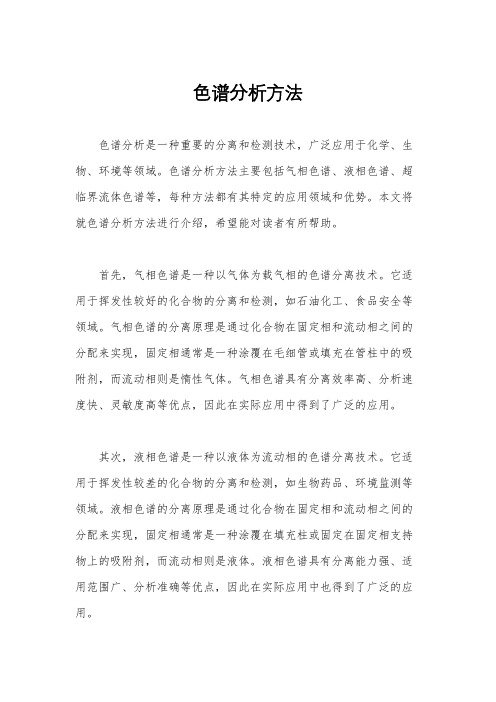
色谱分析方法色谱分析是一种重要的分离和检测技术,广泛应用于化学、生物、环境等领域。
色谱分析方法主要包括气相色谱、液相色谱、超临界流体色谱等,每种方法都有其特定的应用领域和优势。
本文将就色谱分析方法进行介绍,希望能对读者有所帮助。
首先,气相色谱是一种以气体为载气相的色谱分离技术。
它适用于挥发性较好的化合物的分离和检测,如石油化工、食品安全等领域。
气相色谱的分离原理是通过化合物在固定相和流动相之间的分配来实现,固定相通常是一种涂覆在毛细管或填充在管柱中的吸附剂,而流动相则是惰性气体。
气相色谱具有分离效率高、分析速度快、灵敏度高等优点,因此在实际应用中得到了广泛的应用。
其次,液相色谱是一种以液体为流动相的色谱分离技术。
它适用于挥发性较差的化合物的分离和检测,如生物药品、环境监测等领域。
液相色谱的分离原理是通过化合物在固定相和流动相之间的分配来实现,固定相通常是一种涂覆在填充柱或固定在固定相支持物上的吸附剂,而流动相则是液体。
液相色谱具有分离能力强、适用范围广、分析准确等优点,因此在实际应用中也得到了广泛的应用。
此外,超临界流体色谱是一种以超临界流体为流动相的色谱分离技术。
它适用于疏水性化合物的分离和检测,如天然产物提取、药物分析等领域。
超临界流体色谱的分离原理是通过化合物在固定相和流动相之间的分配来实现,固定相通常是一种涂覆在填充柱或固定在固定相支持物上的吸附剂,而流动相则是超临界流体。
超临界流体色谱具有分离速度快、溶解度大、环保性好等优点,因此在实际应用中也得到了广泛的应用。
综上所述,色谱分析方法是一种重要的分离和检测技术,不同的色谱方法有着各自的特点和应用领域。
在实际应用中,我们可以根据样品的性质和分析要求选择合适的色谱方法,以达到最佳的分离和检测效果。
希望本文对读者对色谱分析方法有所帮助,谢谢阅读!。
现代色谱及其在药物分析中的应用综述
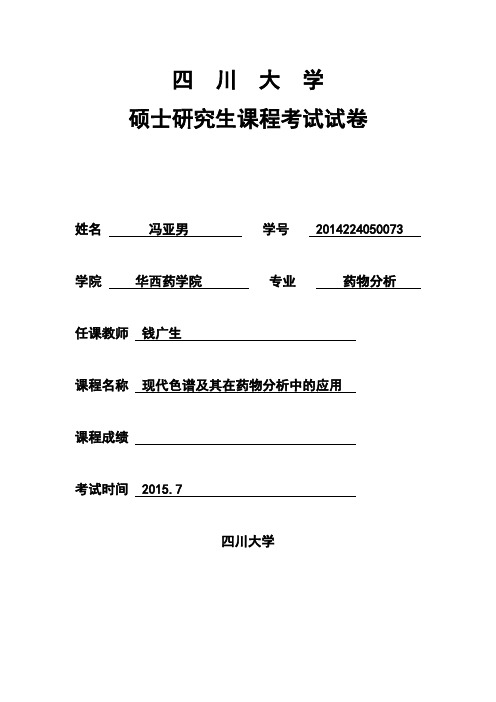
四川大学硕士研究生课程考试试卷姓名冯亚男学号 ************* 学院华西药学院专业药物分析任课教师钱广生课程名称现代色谱及其在药物分析中的应用课程成绩考试时间 2015.7四川大学超高效液相色谱(UPLC)在药物分析领域的应用摘要:超高效液相色谱(Ultra Performance Liquid Chromatography,UPLC)是近年来发展迅速的基于小颗粒填料的液相色谱技术,既能缩短分析时间,又可减少溶剂消耗。
与普通高效液相相比,其柱效及分离能力随着使用1.7µm颗粒度色谱柱填料得到很大提高。
本文对超高效液相色谱近年在药物分析中的应用进行了综述。
关键词:超高效液相色谱;药物分析应用超高效液相色谱(UPLC)技术作为近年来发展起来的分离技术,使用1.7nm颗粒度的色谱柱填料,与传统液相色谱(HPLC)相比较,能够获得更高的柱效,并且在更宽的线速度范围内柱效保持恒定, 有利于提高流动相流速, 能大幅度改善液相色谱的分离度、样品通量和灵敏度, 使液相色谱的分离能力得到进一步的延伸和扩展,极大地提高分析工作的效率和质量,尤其与质谱联用更能显示其优越的性能[1],现已成功应用于农药残留物检测[2,3],水质和环境监测[4,5],化妆品质量控制[6,7],药剂的分析检测和质量控制[8,9],中药复杂组分分析[10,11]及代谢组学[12,13]等领域。
本文介绍了UPLC系统的原理及其优点,并对UPLC 及其联用技术在药物分析领域的应用进行展望。
1 超高效液相色谱的原理及其优缺点1.1 UPLC的基本原理采用细粒径填料(1.7µm)和细内径柱子而获得柱效高达(100,000- 300,000)的液相色谱技术,简称超高效液相色谱。
UPLC系统是利用创新技术进行整体设计,从而大幅度改善色谱分离度、样品通量和灵敏度的最新液相色谱技术。
相对于当今分析速度最快的高效液相色谱(HPLC),UPLC的分析速度提高了9倍,分辨率提高了2倍,灵敏度提高了3倍[14],一次分析所得到的信息量大大超过了高效液相色谱。
色谱文献综述
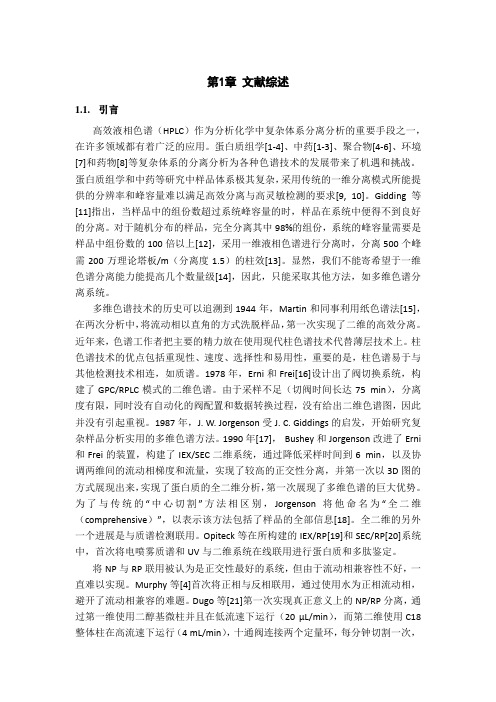
第1章文献综述1.1.引言高效液相色谱(HPLC)作为分析化学中复杂体系分离分析的重要手段之一,在许多领域都有着广泛的应用。
蛋白质组学[1-4]、中药[1-3]、聚合物[4-6]、环境[7]和药物[8]等复杂体系的分离分析为各种色谱技术的发展带来了机遇和挑战。
蛋白质组学和中药等研究中样品体系极其复杂,采用传统的一维分离模式所能提供的分辨率和峰容量难以满足高效分离与高灵敏检测的要求[9, 10]。
Gidding等[11]指出,当样品中的组份数超过系统峰容量的时,样品在系统中便得不到良好的分离。
对于随机分布的样品,完全分离其中98%的组份,系统的峰容量需要是样品中组份数的100倍以上[12],采用一维液相色谱进行分离时,分离500个峰需200万理论塔板/m(分离度1.5)的柱效[13]。
显然,我们不能寄希望于一维色谱分离能力能提高几个数量级[14],因此,只能采取其他方法,如多维色谱分离系统。
多维色谱技术的历史可以追溯到1944年,Martin和同事利用纸色谱法[15],在两次分析中,将流动相以直角的方式洗脱样品,第一次实现了二维的高效分离。
近年来,色谱工作者把主要的精力放在使用现代柱色谱技术代替薄层技术上。
柱色谱技术的优点包括重现性、速度、选择性和易用性,重要的是,柱色谱易于与其他检测技术相连,如质谱。
1978年,Erni和Frei[16]设计出了阀切换系统,构建了GPC/RPLC模式的二维色谱。
由于采样不足(切阀时间长达75 min),分离度有限,同时没有自动化的阀配置和数据转换过程,没有给出二维色谱图,因此并没有引起重视。
1987年,J. W. Jorgenson受J. C. Giddings的启发,开始研究复杂样品分析实用的多维色谱方法。
1990年[17],Bushey和Jorgenson改进了Erni 和Frei的装置,构建了IEX/SEC二维系统,通过降低采样时间到6 min,以及协调两维间的流动相梯度和流量,实现了较高的正交性分离,并第一次以3D图的方式展现出来,实现了蛋白质的全二维分析,第一次展现了多维色谱的巨大优势。
空气颗粒物中多环芳烃分析方法综述

空气颗粒物中多环芳烃分析方法综述随着工业化和城市化的不断发展,大气环境污染已成为人们关注的焦点。
多环芳烃(PAHs)是大气颗粒物中的一类重要污染物,它们对环境和人类健康都具有潜在的危害。
对多环芳烃进行准确、快速、可靠的分析成为了环境监测的重要内容之一。
本文将综述多环芳烃的常用分析方法,包括色谱法、质谱法、光谱法等,以期为大气环境污染的监测与治理提供参考。
一、色谱法色谱分析是多环芳烃分析的重要手段之一。
气相色谱(GC)和液相色谱(HPLC)是其中比较常用的方法。
GC分析多环芳烃时主要采用毛细管色谱柱,它能够高效分离多环芳烃混合物;而HPLC分析多环芳烃则采用反相色谱柱,能够实现对极性较强的多环芳烃的分离。
色谱-质谱联用技术也广泛用于多环芳烃分析,能够实现对多环芳烃的高灵敏度和高分辨率的分析。
二、质谱法质谱分析是多环芳烃分析的另一重要手段。
质谱分析主要包括质谱扫描和质谱定量两种方法。
质谱扫描主要有电子轰击离子化(EI)、化学离子化(CI)、化学反应离子化(CI)等离子源,能够对多环芳烃样品进行分子结构的鉴定;而质谱定量则是通过建立标准曲线或内标法对多环芳烃进行定量分析。
质谱法具有高灵敏度、高特异性和高分辨率等优点,因此在多环芳烃分析中得到了广泛应用。
三、光谱法光谱分析是一种简便、快速的多环芳烃分析方法。
紫外-可见光谱、荧光光谱、红外光谱等光谱技术都被用于多环芳烃的分析。
荧光光谱分析是目前应用较为广泛的一种方法,它能够对多环芳烃进行快速、准确的定性和定量分析。
光谱法还具有较好的选择性和灵敏度,因此在实际分析中得到了广泛的应用。
在环境监测与治理中,对大气颗粒物中多环芳烃的准确分析是非常重要的。
通过本文的综述可知,色谱法、质谱法、光谱法和生物传感器法是目前多环芳烃分析中常用的方法,它们各自具有独特的优势和适用范围。
随着科学技术的不断进步,相信在将来还会有更多更先进的方法用于多环芳烃的分析。
相信通过我们的不懈努力,将能更好地保护我们的大气环境,保障人民的健康。
气相色谱法综述
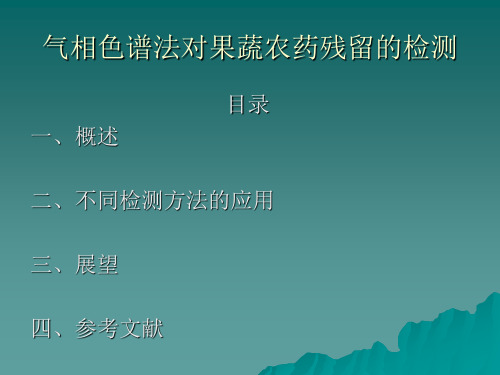
[5]庞艳华等. 水果蔬菜中有机磷农药残留量的气相色谱测定方法研究 [J].安全与环境学报,2005,2(1):30~31. [6]Norazlina Omar,Jamilah Bakar,Kharidah Muhammad.
Determination of organochlorine pesticides in shrimp by gas chromatography-mass spectrometry using a modified QuEChERS approach [J].Food Control . 2013 (2)
谢谢!
气相色谱 - 质谱法结合了气相色谱和质谱 的优点,因而具有分析速度快、灵敏度高、 鉴别能力强等特点,不仅可以同时完成多 组分的定性定量分析,并且能够判别混合 物中未知化合物的分子结构、测定其分子 量,因此目前农药残留检测中开始越来越 多的使用此法[6]。
四、参考文献
[1]陈玲,王春.气相色谱法测定蔬菜中菊酯类农药残留[J]. 新疆环境保护, 2011, 33(1):27~28. [2]陈志涛等.毛细管气相色谱法测定蔬菜中16 种有机磷农药残留量[J]. 台湾农 业探索,2012,12(6):82~85. [3]李艳芳等.气相色谱法快速检测韭菜中 15 种有机磷农药 残留[J].广东农业 科学,2011(5):140~141. [4]马丽娜等.气相色谱法测定黄瓜中 9 种有机磷农药残留方法研究[J].农药科 学与管理,2006,25(7):18~22.
气相色谱法是一种经典的分析方法,其具有高选 择性、高分离效能、高灵敏度和快速等优点,易 气化且气化后热稳定的农药目标物均可采用 GC 分析测定。该法使用高灵敏的检测器可以检测出 1×10-10~1×10-12g 的组分,适合于农药残留的 微量和痕量分析。
色谱分析法概述范文

色谱分析法概述范文色谱分析法是一种广泛应用于科学研究和工业生产中的化学分析方法。
它通过利用物质在固定相和流动相之间的分配行为来分离和测定化合物。
色谱分析方法可以用于分离和确定固、液、气相中的各种有机和无机物质,具有高灵敏度、选择性、重现性和快速分析速度等优点。
气相色谱(GC)是利用气体载气和物质在固定相上的分配行为进行分离和测定的方法。
GC常用于分析挥发性有机物,如石油化工中的燃料、溶剂和有机污染物等。
GC具有高分离效率和分辨率,可以快速分析多种组分。
液相色谱(LC)是利用液体移动相和固定相之间的分配行为进行分离和测定的方法。
LC可分为正相色谱和反相色谱两种类型。
正相色谱是指流动相为非极性溶剂,固定相为极性的固体材料,用于分离非极性有机物和极性无机物。
反相色谱是指流动相为极性溶剂,固定相为非极性的固体材料,用于分离极性有机物。
LC广泛应用于食品、环境、药物等领域的分析。
超高效液相色谱(UHPLC)是一种液相色谱的高效率改进方法,其主要特点是使用高压强制液相通过色谱柱,提高分离速度和分辨率。
UHPLC主要用于分析复杂样品和需要高分辨率的分析。
离子色谱(IC)是利用离子交换柱对离子物质进行分离和测定的方法。
IC主要用于分析离子荧光染料、水中无机离子、药物中的阳离子和阴离子等。
在样品前处理方面,色谱分析法通常需要对样品进行前处理,如提取、分离、浓缩、蒸馏等。
这些步骤有助于减少样品的复杂性和提高分析的灵敏度。
在仪器方面,色谱分析法需要使用高性能液相色谱仪(HPLC)、气相色谱仪(GC)和离子色谱仪(IC)等分析仪器。
这些仪器通过控制流动相和固定相的流动速度和温度等参数来实现样品的分离和测定。
总之,色谱分析法是一种高效、可靠和灵敏的化学分析方法。
它在科学研究、环境保护、食品安全和药物分析等领域起着重要作用,为人们提供了丰富的化学信息。
高效液相色谱法综述
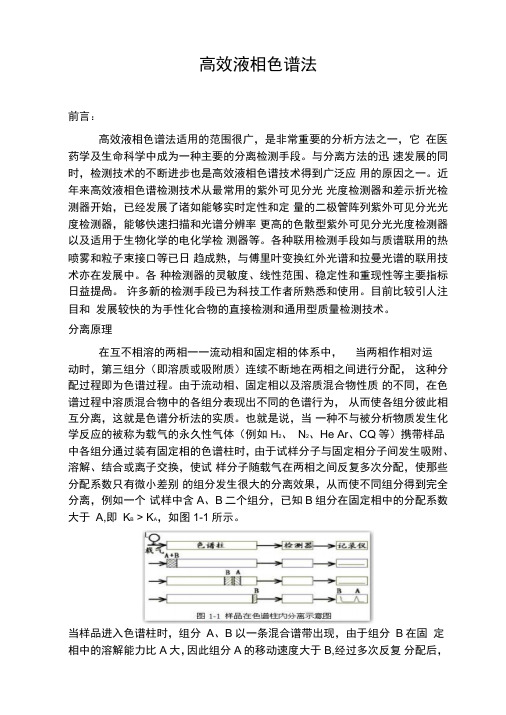
高效液相色谱法前言:高效液相色谱法适用的范围很广,是非常重要的分析方法之一,它在医药学及生命科学中成为一种主要的分离检测手段。
与分离方法的迅速发展的同时,检测技术的不断进步也是高效液相色谱技术得到广泛应用的原因之一。
近年来高效液相色谱检测技术从最常用的紫外可见分光光度检测器和差示折光检测器开始,已经发展了诸如能够实时定性和定量的二极管阵列紫外可见分光光度检测器,能够快速扫描和光谱分辨率更高的色散型紫外可见分光光度检测器以及适用于生物化学的电化学检测器等。
各种联用检测手段如与质谱联用的热喷雾和粒子束接口等已日趋成熟,与傅里叶变换红外光谱和拉曼光谱的联用技术亦在发展中。
各种检测器的灵敏度、线性范围、稳定性和重现性等主要指标日益提咼。
许多新的检测手段已为科技工作者所熟悉和使用。
目前比较引人注目和发展较快的为手性化合物的直接检测和通用型质量检测技术。
分离原理在互不相溶的两相一一流动相和固定相的体系中,当两相作相对运动时,第三组分(即溶质或吸附质)连续不断地在两相之间进行分配,这种分配过程即为色谱过程。
由于流动相、固定相以及溶质混合物性质的不同,在色谱过程中溶质混合物中的各组分表现出不同的色谱行为,从而使各组分彼此相互分离,这就是色谱分析法的实质。
也就是说,当一种不与被分析物质发生化学反应的被称为载气的永久性气体(例如H2、N2、He Ar、CQ等)携带样品中各组分通过装有固定相的色谱柱时,由于试样分子与固定相分子间发生吸附、溶解、结合或离子交换,使试样分子随载气在两相之间反复多次分配,使那些分配系数只有微小差别的组分发生很大的分离效果,从而使不同组分得到完全分离,例如一个试样中含A、B二个组分,已知B组分在固定相中的分配系数大于A,即K B > K A,如图1-1所示。
当样品进入色谱柱时,组分A、B以一条混合谱带出现,由于组分B在固定相中的溶解能力比A大,因此组分A的移动速度大于B,经过多次反复分配后,分配系数较小的组分A首先被带出色谱柱,而分配系数较大的组分B则迟被带出色谱柱,于是样品中各组分达到分离的目的。
色谱分析法实验实验一填充柱气相色谱进样技术练习一、实验目的1综述
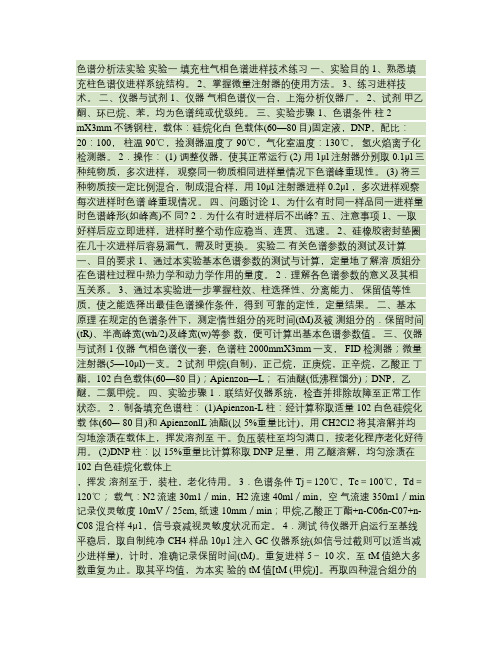
建筑应用文写作习题集目标模块概论一、填空(一)运用应用文专用词语填空1.××省××局:____局×字〔1983〕第073号请示 _____ ,经与××部研究 ____如下:……2. ____部领导指示精神,•我局会同××司××办公室抽调×名同志组成了“××事件调查组”……3.《××××办法》__厂务委员会讨论通过,现发给你们,望结合本单位具体情况__执行。
4.……以上意见,如__,__批转各部属院校。
5.……为了……的需要,特__如下指令。
6. __局大力协助,•我校×××研究所各项筹建工作已基本告一段落。
7.×××来函__,关于××一事,我部完全同意__局意见……特此__。
8.……以大力协作__。
9.以上所请__,以迅即批复__。
10. __生__我校××系××专业××级学员……11. __该厂此类错误做法,上级有关部门曾多次行文,__其有关领导迅即查清问题,限期纠正错误。
12. __悉__总公司成立,谨表__。
13.以上命令__施行,不得__。
14.以上通令,应使全体公民__,切实__执行。
15.随函附送《××××情况统计资料》一份,请__。
16. __国务院领导同志的指示精神,•我们__有关部门,对农村电网改造工作进行了研究。
17.__进一步提高我省企业管理干部的管理素质,决定对在岗企业管理干部有计划地进行培训。
__征得四川省行政管理学院同意,__委托__院举办企业管理专业班……18.以上请示,望予__,并列入一九九一年招生计划。
19. __防止计算机2000年问题,__国务院批准,__将有关问题通知如下。
高效液相色谱法测定脱氢乙酸色谱条件综述
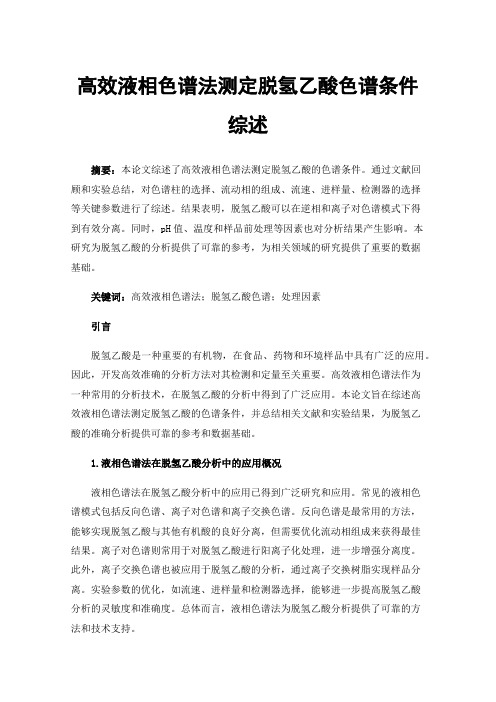
高效液相色谱法测定脱氢乙酸色谱条件综述摘要:本论文综述了高效液相色谱法测定脱氢乙酸的色谱条件。
通过文献回顾和实验总结,对色谱柱的选择、流动相的组成、流速、进样量、检测器的选择等关键参数进行了综述。
结果表明,脱氢乙酸可以在逆相和离子对色谱模式下得到有效分离。
同时,pH值、温度和样品前处理等因素也对分析结果产生影响。
本研究为脱氢乙酸的分析提供了可靠的参考,为相关领域的研究提供了重要的数据基础。
关键词:高效液相色谱法;脱氢乙酸色谱;处理因素引言脱氢乙酸是一种重要的有机物,在食品、药物和环境样品中具有广泛的应用。
因此,开发高效准确的分析方法对其检测和定量至关重要。
高效液相色谱法作为一种常用的分析技术,在脱氢乙酸的分析中得到了广泛应用。
本论文旨在综述高效液相色谱法测定脱氢乙酸的色谱条件,并总结相关文献和实验结果,为脱氢乙酸的准确分析提供可靠的参考和数据基础。
1.液相色谱法在脱氢乙酸分析中的应用概况液相色谱法在脱氢乙酸分析中的应用已得到广泛研究和应用。
常见的液相色谱模式包括反向色谱、离子对色谱和离子交换色谱。
反向色谱是最常用的方法,能够实现脱氢乙酸与其他有机酸的良好分离,但需要优化流动相组成来获得最佳结果。
离子对色谱则常用于对脱氢乙酸进行阳离子化处理,进一步增强分离度。
此外,离子交换色谱也被应用于脱氢乙酸的分析,通过离子交换树脂实现样品分离。
实验参数的优化,如流速、进样量和检测器选择,能够进一步提高脱氢乙酸分析的灵敏度和准确度。
总体而言,液相色谱法为脱氢乙酸分析提供了可靠的方法和技术支持。
2.实验方法与结果在本研究中,我们使用高效液相色谱法对脱氢乙酸进行分析。
我们选择了合适的色谱柱并对其性能进行评价。
通过对流动相组成的优化,找到了最适合分离脱氢乙酸的条件。
同时,我们进行了流速和进样量等操作参数的优化,以提高分析方法的灵敏度和准确性。
我们选择了合适的检测器来检测脱氢乙酸的峰信号。
实验结果表明,在逆相和离子对色谱模式下,能够有效地分离脱氢乙酸和其他有机物。
HPLC综述

高效液相色谱在药物分析中的应用进展谢秋红邵大志(四平市中心人民医院吉林四平 136000)摘要:高效液相色谱法(High—Performance Liquid Chromatography,HPLC)是以液体作为流动相,并采用颗粒极细的高效固定相的柱色谱分离技术。
高效液相色谱对样品的适用性广,不受分析对象挥发性和热稳定性的限制,因而弥补了气相色谱法的不足。
在目前已知的有机化合物中,可用气相色谱分析的约占20%,而80%则需用高效液相色谱来分析。
高效液相色谱已经广泛应用于药物的含量测定、组成分析、质量控制等方面,在药物分析中占主要地位。
其特点是分析速度快、分离效率高、检测灵敏度高、检测自动化、适用范围广、组分易回收、样品处理较简单。
本文从以下几个方面综述了高效液相色谱法在药物分析中的研究进展。
关键词:高效液相色谱法药物分析应用现代药学的迅速发展促进药物及其代谢物在机体内处置过程的研究不断深入,一方面对体内药物分析研究方法和手段提出了越来越高的要求,另一方面也推动了体内药物分析研究方法的蓬勃发展[1]。
HPLC具有分离效能好、分析速率快,应用范围广等诸多优点,已成为药物分析中最重要的分析方法及医学研究与诊断常用的方法之一。
如今,HPLC已成为反映世界各国药典水平先进性的指标之一[2]。
1. 高效液相色谱作为常规分析方法在药物分析中的应用高效液相色谱法作为药物分析中的最主要的分析方法,常被作为常规分析检验方法而广泛应用[3]。
近年来在这个方面的研究比较多,康自华等[4]针对近几年国际奥委会医学委员会公布的禁用表中新增药物及一系列利尿剂的相关化合物进行了研究,比较了不同的提取方法及回收率,建立了同时分析13种利尿剂的高效液相色谱测定方法,检出限小于5ng。
张晓青等[5]采用反相离子对高效液相色谱法研究了唑来膦酸及其有关化合物的色谱分析与分离方法。
该方法简单快速,不需进行复杂的样品处理,唑来膦酸与有关化合物的分离良好,适用于唑来膦酸的常规分析。
液相色谱质谱综述
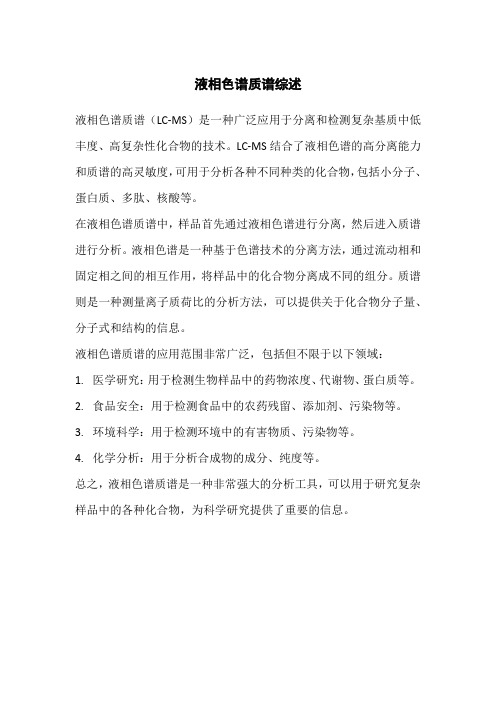
液相色谱质谱综述
液相色谱质谱(LC-MS)是一种广泛应用于分离和检测复杂基质中低丰度、高复杂性化合物的技术。
LC-MS结合了液相色谱的高分离能力和质谱的高灵敏度,可用于分析各种不同种类的化合物,包括小分子、蛋白质、多肽、核酸等。
在液相色谱质谱中,样品首先通过液相色谱进行分离,然后进入质谱进行分析。
液相色谱是一种基于色谱技术的分离方法,通过流动相和固定相之间的相互作用,将样品中的化合物分离成不同的组分。
质谱则是一种测量离子质荷比的分析方法,可以提供关于化合物分子量、分子式和结构的信息。
液相色谱质谱的应用范围非常广泛,包括但不限于以下领域:
1.医学研究:用于检测生物样品中的药物浓度、代谢物、蛋白质等。
2.食品安全:用于检测食品中的农药残留、添加剂、污染物等。
3.环境科学:用于检测环境中的有害物质、污染物等。
4.化学分析:用于分析合成物的成分、纯度等。
总之,液相色谱质谱是一种非常强大的分析工具,可以用于研究复杂样品中的各种化合物,为科学研究提供了重要的信息。
薄层色谱和柱层析综述
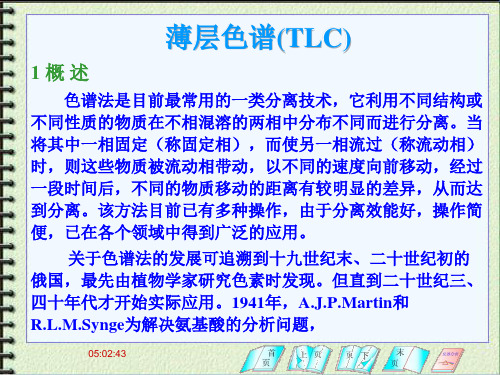
聚酰胺
硅酸镁 多孔玻璃珠
20:45:40
纤维素硅藻土
离子交换剂 反相键合硅胶(硅烷化处理)
5-薄层板的制备
将吸附剂均匀地涂铺在规定尺寸的玻璃板或其它平面板上, 这一过程称铺板或铺层,即制成薄层板。 板的好坏是分离成功与否的关键,好的板要求吸附剂涂铺 均匀,表面光滑,厚度一致。现有预制板出售。 制板方法主要有干法和湿法两种: (1)干法制板 氧化铝和硅胶可用干法铺板,干法铺层比较简便,制得的 板展开速度快,但展开后不能保存,薄层不牢固,喷显色剂时 易吹散。 方法:将吸附剂均匀地撒在薄层板上,两手用两端圈套的 玻璃棒滚动,厚度0.25~3mm,滚动不宜太快,不能停。 0.25mm左右主要是分析和分离用,3mm的厚板主要是制备色 谱用。
20:45:40
将溶剂抽提中的一个相固定在硅胶上,装在柱内,并按色 谱法操作,使另一液相流过柱子,分离获得成功。从此出现了 基于分配原理的分配色谱法,因此获得了诺贝尔奖。以后的发 展采用了纤维素、继而采用滤纸作分配色谱载体,发展了纸色 谱法。薄层色谱法的研究和发展也出现在二十世纪的三、四十 年代,现在已和气、液色谱一起成为最常用的色谱分离、分析 方法。为与柱色谱相区别,并突出纸色谱和薄层色谱的特点, 这两种方法也叫平床色谱法(Flat bed chromatography)或平 面色谱法(Planar chromatography)。 色谱法经过多年的发展已有多种操作形式,其分类方法 也有多种。按固定相和流动相的物态可分为以气体为流动相的 气相色谱(包括气固色谱、气液色谱)和以液体为流动相的液 相色谱(包括液固色谱、液-液色谱);如以固定相的操作方 式以及形状分类则有柱色谱、 纸色谱、薄层色谱;
20:45:40
薄层色谱中,Rf值与组分的分配系数K值有关:
化学中的色谱分析方法

化学中的色谱分析方法色谱分析是一种在化学领域中广泛应用的分析技术,通过分离混合物中的成分并对其进行定量或定性分析。
色谱分析方法主要包括气相色谱(Gas Chromatography, GC)、液相色谱(Liquid Chromatography, LC)和超高效液相色谱(Ultra-high Performance Liquid Chromatography, UHPLC)等。
本文将重点介绍这几种色谱分析方法的原理、应用及特点。
一、气相色谱(Gas Chromatography, GC)气相色谱是一种在气相流动条件下进行分离的色谱技术。
其原理是利用气相载气将样品混合物分离成单独的组分,然后通过检测器进行检测和定量分析。
气相色谱广泛应用于食品、环境、药物、石油化工等领域。
气相色谱的主要特点包括分离效果好、分析速度快、灵敏度高、分辨率高等。
在实际应用中,气相色谱常用于分析挥发性有机物、气体成分、药物、食品添加剂等。
二、液相色谱(Liquid Chromatography, LC)液相色谱是一种在液相流动条件下进行分离的色谱技术。
其原理是利用固定相和流动相之间的相互作用将样品混合物分离成单独的组分,然后通过检测器进行检测和定量分析。
液相色谱广泛应用于生物、药物、环境、食品等领域。
液相色谱的主要特点包括适用性广、分离效果好、灵敏度高、分辨率高等。
在实际应用中,液相色谱常用于分析生物样品、药物、天然产物、环境污染物等。
三、超高效液相色谱(Ultra-high Performance Liquid Chromatography, UHPLC)超高效液相色谱是一种高效、快速的液相色谱技术。
其原理是利用超高压力将样品混合物快速分离成单独的组分,然后通过检测器进行检测和定量分析。
超高效液相色谱广泛应用于生物、药物、环境、食品等领域。
超高效液相色谱的主要特点包括分离效果好、分析速度快、灵敏度高、分辨率高等。
在实际应用中,超高效液相色谱常用于分析生物样品、药物、天然产物、环境污染物等。
分析化学中的色谱技术研究综述
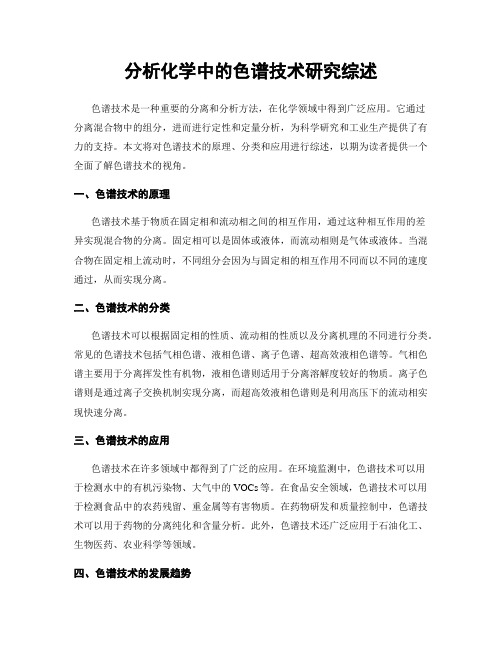
分析化学中的色谱技术研究综述色谱技术是一种重要的分离和分析方法,在化学领域中得到广泛应用。
它通过分离混合物中的组分,进而进行定性和定量分析,为科学研究和工业生产提供了有力的支持。
本文将对色谱技术的原理、分类和应用进行综述,以期为读者提供一个全面了解色谱技术的视角。
一、色谱技术的原理色谱技术基于物质在固定相和流动相之间的相互作用,通过这种相互作用的差异实现混合物的分离。
固定相可以是固体或液体,而流动相则是气体或液体。
当混合物在固定相上流动时,不同组分会因为与固定相的相互作用不同而以不同的速度通过,从而实现分离。
二、色谱技术的分类色谱技术可以根据固定相的性质、流动相的性质以及分离机理的不同进行分类。
常见的色谱技术包括气相色谱、液相色谱、离子色谱、超高效液相色谱等。
气相色谱主要用于分离挥发性有机物,液相色谱则适用于分离溶解度较好的物质。
离子色谱则是通过离子交换机制实现分离,而超高效液相色谱则是利用高压下的流动相实现快速分离。
三、色谱技术的应用色谱技术在许多领域中都得到了广泛的应用。
在环境监测中,色谱技术可以用于检测水中的有机污染物、大气中的VOCs等。
在食品安全领域,色谱技术可以用于检测食品中的农药残留、重金属等有害物质。
在药物研发和质量控制中,色谱技术可以用于药物的分离纯化和含量分析。
此外,色谱技术还广泛应用于石油化工、生物医药、农业科学等领域。
四、色谱技术的发展趋势随着科学技术的不断进步,色谱技术也在不断发展。
一方面,新型的固定相和流动相的开发使得色谱技术的分离效果更加优越,分离能力更强。
另一方面,色谱技术与其他分析技术的结合,例如质谱联用技术,使得分析结果更加准确和可靠。
此外,追求高通量、高效率和高灵敏度也是色谱技术的发展方向。
总结起来,色谱技术作为一种重要的分离和分析方法,在化学领域中发挥着重要作用。
通过对色谱技术的原理、分类和应用的综述,我们可以更好地了解和应用这一技术,为科学研究和工业生产提供更好的支持。
高效液相色谱法-综述
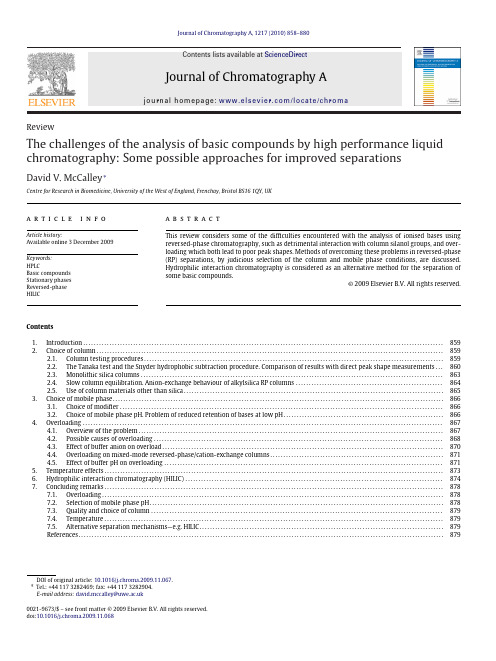
Journal of Chromatography A,1217(2010)858–880Contents lists available at ScienceDirectJournal of ChromatographyAj o u r n a l h o m e p a g e :w w w.e l s e v i e r.c o m /l o c a t e /c h r o maReviewThe challenges of the analysis of basic compounds by high performance liquid chromatography:Some possible approaches for improved separationsDavid V.McCalley ∗Centre for Research in Biomedicine,University of the West of England,Frenchay,Bristol BS161QY,UKa r t i c l e i n f o Article history:Available online 3December 2009Keywords:HPLCBasic compounds Stationary phases Reversed-phase HILICa b s t r a c tThis review considers some of the difficulties encountered with the analysis of ionised bases using reversed-phase chromatography,such as detrimental interaction with column silanol groups,and over-loading which both lead to poor peak shapes.Methods of overcoming these problems in reversed-phase (RP)separations,by judicious selection of the column and mobile phase conditions,are discussed.Hydrophilic interaction chromatography is considered as an alternative method for the separation of some basic compounds.©2009Elsevier B.V.All rights reserved.Contents 1.Introduction.........................................................................................................................................8592.Choice of column....................................................................................................................................8592.1.Column testing procedures..................................................................................................................8592.2.The Tanaka test and the Snyder hydrophobic subtraction parison of results with direct peak shape measurements...8602.3.Monolithic silica columns ...................................................................................................................8632.4.Slow column equilibration.Anion-exchange behaviour of alkylsilica RP columns e of column materials other than silica...................................................................................................8653.Choice of mobile phase..............................................................................................................................8663.1.Choice of modifier ...........................................................................................................................8663.2.Choice of mobile phase pH.Problem of reduced retention of bases at low pH.............................................................8664.Overloading .........................................................................................................................................8674.1.Overview of the problem....................................................................................................................8674.2.Possible causes of overloading ..............................................................................................................8684.3.Effect of buffer anion on overload...........................................................................................................8704.4.Overloading on mixed-mode reversed-phase/cation-exchange columns..................................................................8714.5.Effect of buffer pH on overloading ..........................................................................................................8715.Temperature effects.................................................................................................................................8736.Hydrophilic interaction chromatography (HILIC)..................................................................................................8747.Concluding remarks.................................................................................................................................8787.1.Overloading..................................................................................................................................8787.2.Selection of mobile phase pH................................................................................................................8787.3.Quality and choice of column ...............................................................................................................8797.4.Temperature.................................................................................................................................8797.5.Alternative separation mechanisms—e.g.HILIC.............................................................................................879References...........................................................................................................................................879DOI of original article:10.1016/j.chroma.2009.11.067.∗Tel.:+441173282469;fax:+441173282904.E-mail address:david.mccalley@0021-9673/$–see front matter ©2009Elsevier B.V.All rights reserved.doi:10.1016/j.chroma.2009.11.068D.V.McCalley/J.Chromatogr.A1217(2010)858–8808591.IntroductionThe analysis of basic compounds by high performance liquid chromatography(HPLC)continues to be of interest,as over70% of pharmaceuticals are bases(with about20%being acids)[1–3].A large number of compounds of biomedical and biological signifi-cance are also bases.Reversed-phase(RP)separations are by far the most common in liquid chromatography(LC),due to advantages that include ease of use with gradient elution,compatibility with aqueous samples,versatility of the retention mechanism allowing changes in the separation to be brought about by changes in pH, organic modifier or additives,and long experience with the tech-nique,allowing the rapid establishment of suitable experimental conditions for the analysis of a given sample[4].Nevertheless,it has been recognised for a long time that the analysis of basic com-pounds poses particular difficulties in RP separations.Many of these problems are associated with the complex structure of the surface in silica-based RP packings,shown in Fig.1.The surface concentra-tion of silanols on bare silica is reported to be about8.0mol m−2 [5].C18ligands are too bulky to react completely with all silanols; thus,a maximum coverage of4–4.5mol m−2can be achieved.A further number of reactive silanols can be“endcapped”by reac-tion with smaller silylating agents such as trimethylchlorosilane, but as many as50%of the original silanol groups remain unreacted on a typical RP column.The average p K a of these silanol groups is around7.1,but their acidity can be enhanced by the presence of metal impurities in the silica.Some groups appear to be suffi-ciently acidic that their ionisation cannot be entirely suppressed using acidic mobile phases with a pH within the stability limit of typical RP columns(2.5–7.5).Over this range of operational pH values,basic compounds are likely to be ionised,leading to ionic interactions with ionised silanol groups.BH++SiO−M+→SiO−BH++M+(1) where BH+represents the protonated base,and M+the mobile phase buffer cation.The problem of poor column efficiency(N)and exponentially tailing peaks shown by small quantities of bases is often attributed to this mixed mechanism process of hydropho-bic interaction and ion-exchange with the silanols.The slower sorption–desorption kinetics of silanol ion-exchange sites(kinetic tailing)with sample ions may be responsible[6],which will occur regardless of sample size.The simple existence of two retention processes cannot per se be the sole cause of tailing,as mixed-mode phases with carboxylic acid functions embedded within a hydrophobic chain can show excellent peak symmetry for bases[7]. However,the kinetics of interaction of such embedded groups,and the stereochemistry around the active site,could be completely dif-ferent from that of ionised silanols,which may be buried beneath the hydrophobic chains on classical C18phases.Instead of sim-ple ion-exchange sites,Neue et al.[8]have proposed the existence of strong synergistic sites with combined RP and ion-exchange properties.The overall retention for bases was described by the equation:k=k RP+k IX+k∗RP k∗IX(2) where k is the total retention,k RP is the hydrophobic contribu-tion,k IX is the ion-exchange contribution from surface silanols,and k∗RP k∗IX is a multiplicative contribution of both processes.These syn-ergistic sites could correspond to the subset of very high-energy sites with slow kinetics which have been long suspected to be the cause of exponential tailing for bases,as they appear to be domi-nant in the retention process.It was shown that this type of tailing is not responsive to small changes in sample load in RP–LC at low pH[6].This result might indicate that exponential tailing is not caused by overload of a small number of strong sites on the column. In contrast,overload often gives rise to right-angled triangle peak shapes when ionisation of silanols is suppressed in RP–LC when working at low pH.Overload tailing still occurs even for the most modern columns operated under conditions where there are no or a negligible number of ionised silanols on the column surface.It was recognised more than20years ago that bonded phases synthesised from pure silica(Type B phases)made from the hydrol-ysis of metal-free tetraalkoxysilanes resulted in reduced silanol acidity,and their use has considerably improved the analysis of bases[9].Only small contamination of such materials occurs dur-ing the processing of such packings,or from the water used in the hydrolysis.Nevertheless,some other features of the analysis of these solutes(such as overloading)remain problematic,and these issues have not been resolved by the use of high-purity silica.Already in1988,Snyder and co-workers[10]had reviewed the problems of analysis of basic solutes and had proposed some pos-sible solutions.The following recommendations were made: (a)Judicious selection of the column to reduce the number of avail-able acidic sites.(b)Reduction of the mobile phase pH to suppress ionisation of thesilanols.(c)Increasing the mobile phase pH above the analyte p K a,such thatthe analyte is unprotonated.(d)Addition of a silanol blocker such as triethylamine to the mobilephase to interact preferentially with ionised silanols.(e)Reduction of the sample concentration to alleviate the satura-tion of the acidic sites.Most of the arguments in this paper remain true more than20 years later,and these conclusions can be used as a simple guide for the chromatographer aiming to achieve the best separations for basic solutes.Perhaps only the use of silanol blocking agents has fallen somewhat out of favour,as these are less necessary with modern high-purity silica phases,and can also have some undesirable effects.Such effects include the generation of addi-tional background in HPLC–MS,the difficulty of removal from the stationary phase after use leading to permanent alteration of its properties,and even chemical reaction with some solute types.This topic,and some other well-known aspects of the chromatography of bases have been covered adequately in earlier reviews[11–13]. However,other features of the chromatography of these“difficult”compounds are still extensively debated in the literature,for exam-ple,the problem of their ready overloading in RP separations.This review will concentrate on the latest research in these topics,while attempting to summarise briefly previousfindings.Thus,it will con-sider RP column choice by use of evaluation data obtained from the Tanaka and the Snyder“hydrophobic subtraction”tests;current theories and the effect of overload for ionised solutes;the use of high pH to improve peak shape;whether temperature is a useful parameter in improving peak shape;andfinally whether other sep-aration mechanisms such as HILIC can provide a viable alternative to RP–LC for the analysis of bases.2.Choice of column2.1.Column testing proceduresThe selection of an appropriate RP column for the analysis of bases can be a daunting task,as now many hundreds are com-mercially available,with a considerable number recommended especially by their manufacturers for the analysis of basic solutes. Nevertheless,several databases are now available where a large number of different columns have been subjected to the same test procedure by the same group of workers on the same or similar instruments,allowing a useful and objective comparison of perfor-860 D.V.McCalley /J.Chromatogr.A 1217(2010)858–880Fig.1.Structures present on a typical RP monomeric-bonded silica (C8)endcapped with trimethylsilyl groups.After U.D.Neue,“Silica Gel and its derivatization for Liquid Chromatography”,in “Encyclopedia of Analytical Chemistry”,R.A.Meyers,Ed.,John Wiley &Sons,Ltd.,Chichester (2000)11450–11472.mance to be made.A question arises as to the validity of databases constructed by evaluation of only a few or even a single column of a given type,as to whether the results obtained may be truly repre-sentative of the performance of this brand,due to column to column and batch to batch variations.However,a careful study [14,15]has suggested that columns from major manufacturers actually show a rather high degree of reproducibility,probably resulting from the use of stringent quality control procedures.Indeed,the industry is likely to be self-regulating to a degree,as dissatisfied customers would switch to the use of more reproducible brands.Tight reten-tion specifications exist in the HPLC user environment,especially in the pharmaceutical industry,and changes in the column can jeop-ardise product release.However,it is possible that a manufacturer could be forced to change the sourcing of a production raw mate-rial,which might occur for example,if the column manufacturer does not make their own silica.Thus,under some circumstances,a recently purchased column may not behave in the same way as one tested several years beforehand.Nevertheless,we believe that such situations are rare,and in most cases,manufacturers strive to main-tain the reproducibility of their products over a long period of time,as many customers have established methods on a given brand of phase.It appears more common to introduce a new name or name variant of an existing phase to mark definitively such changes or improvements to the production process.Taking this factor,and the reasonable reproducibility of commercial columns into account,it seems that the results of tests on a particular brand of column would generally reflect the performance of that brand throughout the product lifetime.Both of the column evaluation methods described in detail below incorporate strongly basic compounds as test probes.In each test,their retention is monitored at low and intermediate pH val-ues.Columns which give relatively low retention of basic probes are also likely to give higher efficiency for basic solutes,as shown by correlation studies for at least one of the procedures (see below).2.2.The Tanaka test and the Snyder hydrophobic subtraction parison of results with direct peak shape measurementsWhile many different column testing methods have been devel-oped,two have become prominent and have the distinct advantage that databases of results for many hundreds,rather than just a few columns,are available.The Tanaka method [16]and the hydropho-bic subtraction procedure developed by Snyder et al.[17]both incorporate tests which allow a user to select phases that are likely to be suitable for the separation of basic compounds.We will consider here the Tanaka method as adapted and applied by Euerby and Petersson [18]to the evaluation of over 200commercial columns that can be compared on a freely available program from Advanced Chemistry Development [19].These databases appear to be updated periodically;for instance,the ACD database contains evaluations of recently introduced sub-2m phases.An alternative adaptation of the Tanaka procedure and its application to a large number of different stationary phases has also been made [20],and data are again freely available [21].A fourth testing scheme is that published by the US Pharmacopeia.This protocol is an adaptation of the work of Sander and Wise [22].For activity towards bases,this method uses the tailing factor of amitriptyline (the same probe as used in the Snyder–Dolan procedure).At the time of writing,the database contained fewer columns than the two major proce-dures (∼100)and will not be considered further here.However,data for both this procedure and the Snyder–Dolan (S–D)method are available on the USP website [23].In the Tanaka–Euerby (T–E)procedure,columns are tested by measurement of k for pentylbenzene as a measure of sur-face area and surface coverage;hydrophobic selectivity from the ratio of k (pentylbenzene)/k (butylbenzene);shape selectivity from k (triphenylene)/k (o-terphenyl);hydrogen bonding capac-ity from k (caffeine)/k (phenol)in unbuffered methanol–water;total ion-exchange capacity from k (benzylamine)/k (phenol in methanol–phosphate buffer pH 7.6;and acidic ion-exchange capacity from k (benzylamine)/k (phenol)in methanol–phosphate buffer pH 2.7.The latter three tests are of particular interest for the analysis of basic solutes.The program [19]allows the comparison of the similarities and differences between various columns,and per-mits the separate weighting of the various factors—for example,columns can be ranked according solely to their total ion capacity at pH 7.6if so desired.The S–D model recognises that hydrophobic retention is the dominant process in RP chromatography,and in the absence of other retention mechanisms,plots of log k for one column versus another should be a straight line.However,these other mechanisms give rise to scatter in the plots.Clearly,ion-exchange and hydrogen bonding are important contributors to the retention of basic solutes.The general equation for retention in theD.V.McCalley/J.Chromatogr.A1217(2010)858–880861Table1Evaluation of some selected RP columns by two different procedures.For details on the procedure,see text.Column name k pentylbz k(pentbz)/k(butbz)k(triphen)/k(terph)k(caff)/k(phen)k(bzm)/k(phen)2.7k(bzm)/k(phen)7.6Tanaka–Euerby procedureChromolith 4.22 1.24 1.310.480.120.63Discovery Amide 1.65 1.35 1.810.490.190.44Discovery C18 3.32 1.48 1.510.390.100.28Inertsil ODS-37.74 1.45 1.290.480.010.29Resolve C18 2.40 1.46 1.59 1.29 1.23 4.06Spherisorb ODS-2 3.00 1.51 1.560.590.230.76Symmetry C18 6.51 1.46 1.490.410.010.68Symmetry Shield RP18 4.66 1.41 2.220.270.040.20Xterra MS C18 3.52 1.42 1.260.420.100.35Xterra RP18 2.38 1.29 1.830.330.070.20H S A B C(2.8)C(7.0)Snyder procedureChromolith 1.0030.0290.008−0.0140.1030.187 Discovery Amide0.7200.013−0.6250.218−0.092−0.025 Discovery C180.9840.027−0.1280.0040.1760.153 Inertsil ODS-30.9900.022−0.146−0.023−0.474−0.334 Resolve C180.968−0.1270.335−0.046 1.921 2.144 Spherisorb ODS-20.962−0.0760.070.0340.908 1.263 Symmetry C18 1.0520.0630.018−0.021−0.3020.123 Symmetry Shield RP180.8500.027−0.4110.093−0.7280.136 Xterra MS C180.9840.012−0.143−0.0150.1330.051 Xterra RP180.757−0.043−0.4830.097−0.170−0.173model is:log˛=log k/log k(ethylbenzene)=Á Hhydrophobic − S∗steric resistance(to bulky interactions)+ˇ Acolumn H-bond acidity(non-ionised silanols)+˛ BH-bond basicity(from sorbed water)+Ä Cion interaction(ionised silanols)(3)Ethylbenzene is used as a non-polar reference solute.Greek letters represent empirical,eluent-and temperature-dependent proper-ties of the solute,which are relative to the values for ethylbenzene, for which all solute parameters are identically zero.The selection of the optimum probes for evaluation of each retention mode has been made from detailed studies.Bold capitals represent eluent-and temperature-independent properties of the column;these val-ues are relative to a hypothetical average Type B C18column.Any column which behaves identically to this hypothetical reference column will have H=1and all other values S*,A,B,C=0.The dataset of columns evaluated by this procedure is even larger than that for the T–E procedure and presently extends to at least400columns.In some versions of the program,different weightings can be assigned to each evaluation parameter,as in the Euerby procedure.Results for some RP columns selected from each database are shown in Table1.The T–E data show clearly that the older Type A bonded phases(Resolve C18and Spherisorb ODS-2)give higher retention of benzylamine relative to phenol at pH7.6(alpha values 4.06and0.76,respectively)compared with newer Type B phases based on highly pure silica(Discovery C18and Inertsil ODS-3, alpha values0.28and0.29,respectively).Similarly with the S–D method,values of C(7.0)for Resolve C18and Spherisorb ODS-2 are high(2.144and1.263,respectively)compared with Discov-ery C18and Inertsil ODS-3(0.153and−0.334,respectively.Values of alpha(benzylamine/phenol)at pH2.7and values of C(2.8)are also higher for the Type A compared with the Type B phases using both procedures,indicating general agreement between them. Snyder and co-workers[24]have correlated a published dataset of“silanol activity”for a number of RP columns(measured by the average plate number for amitriptyline and pyridine with methanol-phosphate buffer pH6.0)with values of C at pH6.0,inter-polated from C(2.8)and C(7.0).Columns with a highvalue of C(6.0) correlated with columns of high silanol activity,and those with low values of C(6.0)with low silanol activity.In a later study[6]95%of Type B columns(designated either on the basis of manufacturer claims,or on the date a column wasfirst sold)were shown to have C(2.8)≤0.25,while only11%of Type A columns satisfied this crite-rion.Tailing of basic solutes(as measured by the asymmetry factor A s)was minimal for columns with C(2.8)<0.25(i.e.Type B columns) and tended to increase for larger values of C(2.8).From Table1,the Type A phases Resolve C18and Spherisob-ODS-2,now identified as such due to values of C(2.8)≥0.25,also give the highest values of hydrogen bonding acidity(parameter A,0.335and0.07,respec-tively,determined from the retention of amide probe compounds). Similarly,these phases also gave the highest relative retention of caffeine/phenol in the Tanaka procedure(1.29and0.59,respec-tively).The data can also be used to compare the effect of other features,e.g.the performance of embedded polar group phases (EPG)and the equivalent conventional C18phase,manufactured on the same silica.EPG phases include columns with embedded amide groups within the hydrocarbon chain:or carbamate groups:EPG phases have been proposed to give better peak shapes for the analysis of bases[24,27].The incorporation of an EPG in XTerra RP18reduces somewhat the Tanaka alpha(benzylamine/phenol) 7.6parameter to0.20,compared with0.35for the XTerra MS C18 column.Similarly,the S–D C(7.0)parameter is reduced to−0.173 for the EPG compared with0.051for the conventional phase.It is862 D.V.McCalley /J.Chromatogr.A 1217(2010)858–880possible that the reduced retention of benzylamine and other bases may be caused by a layer of water that is adsorbed close to the surface of EPG phases,providing some deactivating effect for the silanol groups [25,26].Other authors have compared conventional and EPG phases bonded on the same type of silica,on the basis of peak shape measurements.It was found that on average,peak shapes were indeed improved on the latter phases [27].Neverthe-less,it appears that the EPG technology gives more improvement in performance with phases bonded on older impure silicas,rather than the modern Type B silicas [27].This result seems to be reflected in the somewhat inconclusive data from Table 1concerning the rel-ative retention of bases on conventional and EPG phases.Thus the Discovery EPG phase (amide)has a slightly larger value of the T–E alpha (benzylamine/phenol)7.6parameter (0.44)compared with the regular C18phase (0.28).In contrast,the S–D C (7.0)parameter is smaller on Discovery Amide (−0.025)compared with Discovery C18(0.153).Similarly,while the T–E procedure indicates a con-siderable lower value of alpha (benzylamine/phenol)at pH 7.6for Symmetry Shield (0.2)compared with Symmetry C18(0.68),the S–D C (7.0)parameter for the EPG phases is slightly greater (0.136)compared with the regular phase (0.123).Euerby and Petersson pointed out that the extra retentiveness of phenols on EPG phases might invalidate the results of tests for silanophilic activity which involve the use of such solutes.They therefore suggested substitut-ing benzyl alcohol for phenol in the Tanaka test.Benzyl alcohol has retention properties similar to those of phenol but does not show excess retention on EPG phases [28].These particular comparisons point to some possible differences in the compatibility of column evaluations from either method.The Hoogmartens group looked more generally at the compati-bility of results from the S–D method and their own adaptation of the Tanaka procedure [29],finding a rather poor overall correlation between the two approaches.In a previous paper,this group had demonstrated a good correlation between their own method and the Euerby results.This latter finding is perhaps not surprising,as both are based on the Tanaka method.The problem of compatibility of the S–D and Tanaka methods may well be in the different mobile phase conditions and different probe solutes used in these tests.The S–D procedure uses the retention of the strong bases amitriptyline and nortriptyline in acetonitrile–phosphate buffer to calculate the cation-exchange term C (2.8)and derives the value of C (7.0)from the C (2.8)results by multiplying by the ratio of the retention fac-tors of the quaternary amine berberine at pH 7.0and 2.8;the T–E benzylamine tests use methanol as the organic modifier.Indeed the use of these different modifiers may explain the somewhat differ-ent evaluations of the EPG phases by either method.Even using the same mobile phase conditions,McCalley and Brereton [27,30–32]showed that peak shape data was not consistent between different basic probes.Thus,for example there was little correlation between A s for codeine and nortriptyline when using methanol–phosphate buffers at pH 3.0,whereas either of these solutes has been used as a single test compound to evaluate the relative silanol activity of different phases.One phase (Waters Symmetry Shield)gave,of 9highly inert RP columns,the highest N and lowest A s for nico-tine using acetonitrile–phosphate buffer at pH 7.0but the lowest efficiency for analysis of pyridine.Fig.2shows a principal compo-nents analysis (PCA)loadings plot for analysis of nine basic solutes on eight different RP columns using a mixture of methanol with a pH 3.0buffer.Lines can be drawn from the centre of the plot to each data point.Parameters that are opposed (i.e.appear at 180◦)measure equivalent but opposite trends.Thus N and A s values are opposed,with efficiency increasing as asymmetry decreases,as expected.Parameters that are at 90◦,like the asymmetry factors of pyridine and quinine,measure unrelated trends,and thus may be evaluating relatively different aspects of the detrimental inter-action of bases with the column surface.Conversely,the asymmetry parameters of nortriptyline and diphenhydramine have a smaller angle between them,and may be measuring more related proper-ties.It might therefore not be necessary to include both substances in a test mix for these particular mobile phase conditions.For over-all evaluation of column properties exploring different aspects of detrimental interactions,a test mix could include five compounds:codeine,quinine,amphetamine,nortriptyline and pyridine.The ranking of columns at pH 7using methanol was different from that at pH 7using acetonitrile;note that these correspond to the differ-ent modifiers of the T–E and S–D evaluation schemes,respectively.Snyder and co-workers [6]also observed that the tailing of basic (cationic)solutes on a given column appeared to be solute specific,finding that values of A s for the bases amitriptyline,nortriptyline,the quaternary compound berberine,and 4-n -hexylaniline corre-lated extremely poorly (r 2=0.01–0.19).The use of multiple basic test solutes and different mobile phase modifiers at different pH values would be a considerable task for the construction of these column evaluation databases.However,inclusion of a range of test compounds would undoubtedly improve the performance of these databases.It seems certain that these differences in test solutes and conditions contribute to the lack of correlation between the S–D and T–Etests.Fig.2.PCA loadings plots based on retention factor (k ),column efficiency (N ),Dorsey–Foley column efficiency (N df )and asymmetry factor (A s ).Data for eight different Type B reversed-phase columns and nine different probe compounds with methanol–phosphate buffer pH 3.0as mobile phase.See [30].。
- 1、下载文档前请自行甄别文档内容的完整性,平台不提供额外的编辑、内容补充、找答案等附加服务。
- 2、"仅部分预览"的文档,不可在线预览部分如存在完整性等问题,可反馈申请退款(可完整预览的文档不适用该条件!)。
- 3、如文档侵犯您的权益,请联系客服反馈,我们会尽快为您处理(人工客服工作时间:9:00-18:30)。
二、操作技术
1.层析纸和层析板
特制的色层滤纸。按需要剪裁成长条形(或筒型)。层
析板是用专门的涂布器把浆状的吸附剂(硅胶或氧化铝 , 200~250目)均匀地涂在长条形玻璃板上(厚度0.15 ~0.5mm)。干燥后即可使用。
2018/10/14
2.展开剂
由一种或多种溶剂按一定比例组成。如用纸层析分离
2018/10/14
缺点:
• • 缺点: 分离效率较低,不适用挥发性试 应用:平板色谱法在染料、农药、医药、 样分离。定性定量不便。 有机酸碱类化合物、糖类化合物、氨基酸、
蛋白质及中草药中有效成分的分离分析中经
常被使用。也可以用于无机离子的分离。还 经常作为高效液相色谱章 色谱分析法
第十节 纸层析和薄层层析法
一、纸层析和薄层层 析分离过程 二、操作技术 三、特点及应用
2018/10/14
一、纸层析和薄层层析分离过程
纸层析和薄层层析也属于色谱分析法。但与其它色谱 方法不同的是在分离过程中一般不使用动力源。 纸层析和薄层层析 流动相的移动是依靠毛 细作用。 将试样点在色谱滤纸 或层析板的一端,并将 该端浸在作为流动相的 溶剂(常称之为展开剂 )中,随着溶剂向上的 移动,经过试样点时, 带动试样向上运动。
氨基酸时,常用的展开剂组成和配比为:正丁醇:乙酸:
水=4:1:1。
2018/10/14
3. 点样
用微量注射器或玻璃毛细管吸取 一定量试样点在原点上。试样点的直 径一般应小于 5mm。可并排点多个试 样同时展开。
2018/10/14
4.显色、检测
有些组份在紫外光照射下产生荧光,可在紫外灯下
用铅笔将组份斑点描绘出来。常用的显色方法有喷洒显
色剂、碘蒸气熏或氨水熏等。
2018/10/14
三、特点及应用
• 平板色谱简单、方便、及操作费用低,
•
•
可以在一块层析板上同时展开多个试样及
采用方形薄层板还可以方便的进行二维展
将多条滤纸同时展开。
开,即按一般方法展开后,改变方向和展开
剂再次展开,进一步改善分离效果。 • • 试样一般不需要经过预处理即可分离。
请进入下一节:
第一节 第二节 第三节 第四节 第五节 第六节 第七节 第八节 第九节 第十节 色谱法概述 气相色谱仪 色谱理论基础 气相色谱操作条件选择 色谱定性、定量方法 毛细管色谱 液相色谱法 离子色谱法 高效毛细管电泳 薄层色谱与纸色谱法
结束
